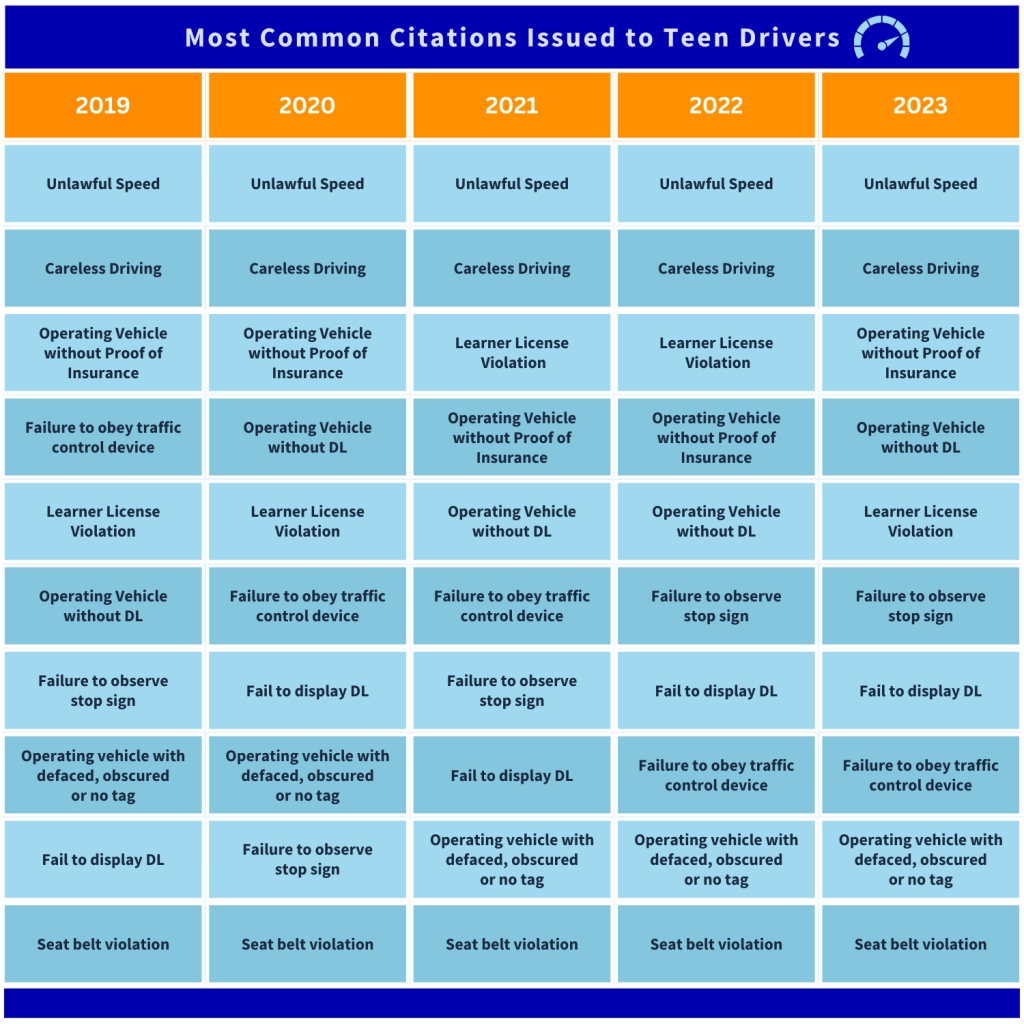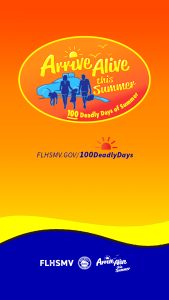Safe Summer Travel
100 Deadly Days of Summer

The 100 days between Memorial Day and Labor Day, referred to as the 100 days of summer, are nationally known as the most dangerous time for teen drivers. Studies by AAA and The Florida Safe Teen Driving Coalition both indicate a sharp increase in fatal crashes with teen drivers behind the wheel, thereby dubbing the time as the 100 Deadliest Days of Summer.
In Florida, statistics show the month of March as the deadliest for teen drivers, with both Spring Break and St. Patrick’s Day showing increases in dangerous driving behavior, often resulting in fatal crashes or crashes involving serious bodily injury.
Teen drivers must be aware of the risks associated with dangerous driving behaviors, and being issued a citation or a warning is considerably different than causing a crash that injures or kills someone.
Before operating a vehicle, teens should ensure that they are prepared to be behind the wheel, that their vehicle is in working order, and that they are aware of traffic laws and the consequences of failing to comply.
Teen Driver Safety:
Talk to your Teen about Vehicle Preparedness and what they should carry with them before getting behind the wheel.
- As of May 5, 2024, over 205K Florida teens between the ages of 15-19 were driving with a learner’s license across the state. It is critical that parents talk to their teens and ensure they are aware of traffic laws, any restrictions they may have on their licenses, and what they should carry with them when operating a motor vehicle.
- All drivers (including teens) should carry with them a valid Florida Driver License or Learners Permit when they are behind the wheel. They should also have proof of insurance and understand that their license plate should not be obscured, defaced or missing.
- In 2023, operating a motor vehicle without proof of insurance (8,465), operating a motor vehicle without a driver license (8,296), learner license violation (8,160), failure to display driver license (5,713) and operating a motor vehicle with an obscured, defaced or no tag (4,875) were in the top ten most common citations issued to teen drivers.
- Check in with your teen. Make sure that they have the appropriate credentials and documents (license, registration, proof of insurance) in their vehicle or on their person before they get behind the wheel, and that their tag is attached and unobscured.
Traffic Laws for Florida Teens:
In addition to traffic laws for all drivers, there are additional requirements that apply to drivers who are minors.
- NO moving violation convictions for one year from learner’s license date of issuance
- If the minor receives a moving traffic conviction while they have a learner’s license, the one-year period they are required to hold their learner’s license will be extended for one year from the date of the conviction or until they are 18 years old, whichever happens first.
- Section 322.161, Florida Statutes
- Compliance with school attendance
- If the minor is not in compliance with school attendance, their driving privilege can be suspended, or the minor may be ineligible to obtain a license until providing proof that they have attended school for 30 consecutive days.
- Section 322.091, Florida Statutes
- Zero Tolerance
- Drivers under the age of 21 with a blood alcohol level of .02% or more will have their license immediately suspended for six months. A second offense will result in a one-year suspension. Refusal to submit to testing (first offense) results in a suspension for a period of 12 months and 18 months for a second offense.
- Section 322.2616, Florida Statutes
- 6+ points within 12 months “Business Purposes Only” restriction
- If the minor receives six points on their driving record within a 12-month period, their driver license is automatically restricted to “Business Purposes Only” for 12 months or until they are 18, whichever happens first. If they receive additional points during this restricted period, the restriction is extended 90 days for each additional point.
- Parents can rescind a teens license
- The parent or guardian who signs the Parental Consent Form can rescind responsibility for the minor’s driving privilege and cancel their license. Visit our Teen Safety webpage for more information.
- Section 322.10, Florida Statutes
- Convicted of tobacco possession
- If the minor is convicted for possession of tobacco or nicotine products, their learner’s license will be revoked for a minimum of 30 days.
- Section 322.056, Florida Statutes
Requirements for Teens Obtaining a Florida Learner’s License
- Must be at least 15 years old.
- If under 18 years old, must have a signed/notarized Parental Consent Form (stepparents may not sign unless they have legally adopted the minor child).
- Proof of Traffic Law and Substance Abuse Education (TLSAE) course completion.
- Pass a vision and hearing test – testing is conducted in a service center.
- Pass Class E Knowledge Exam.
- Prepare for the exam by studying the Official Florida Driver License Handbook
- Testing options
- The exam consists of 50 multiple-choice questions about traffic laws and traffic signs. The passing score is 80 percent or 40 out of 50 questions; and
- Must provide documents needed to establish proof of identity, proof of social security number and proof of residential address. Please visit flhsmv.gov/WhatToBring for a list of acceptable documents.
Requirements for Teens Obtaining a Florida Driver License
- Must be at least 16 years old.
- Must hold learner’s license for at least one year (12 months) OR reach age 18, whichever comes first.
- A parent, legal guardian or responsible adult over 21 years old must complete the Certification of Minor Driving Experience Form, certifying the driver has 50 hours of driving experience, of which 10 hours must be at night. Use this Practice Log Sheet to track driving experience time.
- NO moving violation convictions for one year from learner’s license date of issuance (OR may have one moving violation as long as adjudication was withheld);
- Must pass Class E Driving Skills Test.
- The vehicle used for the driving test must have a valid registration, proof of insurance and pass a basic vehicle inspection that is conducted by the driver license examiner to determine that it is safe for a driving test; and
- Must provide documents needed to establish proof of identity, proof of Social Security number and proof of residential address if you have not previously provided these documents. Please visit flhsmv.gov/whattobring for a list of acceptable documents.
GRADUATED DRIVER LICENSING (GDL) LAWS allow teen drivers to safely gain driving experience under lower-risk conditions before obtaining full driving privileges. These laws outline limits and restrictions for new drivers, ages 15 through 17. Florida’s GDL laws are designed to help teens gradually and safely build their skills and experience behind the wheel. It is important for teens and their parents to understand these laws and obey them.
| License Type | Hours | Note: |
|---|---|---|
| Learner's License | Daylight hours for first three months after license issued - until 10 p.m. after three months |
|
| Driver License 16 years old | Driving is only allowed between 6 a.m. and 11 p.m. | Unless driving to or from work OR accompanied by a licensed driver 21+ |
| Driver License 17 years old | Driving is only allowed between 5 a.m. and 1 a.m | Unless driving to or from work OR accompanied by a licensed driver 21+ |
Most Common Citations Issued to Teen Drivers
Since 2015, speed has been the top violation teen drivers have been cited for, with careless driving coming in at a close second. Other citations within the top 10 most commonly related to a driver’s preparedness include failing to display a DL, operating a motor vehicle without a DL, operating a vehicle without proof of insurance and motor vehicle tag obstruction, and defaced or no tag on the vehicle. Although not in the top 10, buckling up is always necessary for safety.

Impaired Driving
Drugs and alcohol have real effects on your body. Driving under the influence (DUI) inhibits your ability to drive safely. For inexperienced or young drivers this could be even more dangerous.
It is important to make sure that your teen is aware that alcoholic beverages, controlled substances, prescriptions, and over-the-counter medications all cause impairment.
The legal drinking age in Florida is 21. Anyone under the age of 21 in possession of alcohol can be cited for a second-degree misdemeanor, which can lead to costly court fees, fines and other lasting consequences. It is illegal to sell alcohol to anyone under 21 or buy alcohol for anyone under 21.
Possession of an open alcoholic beverage container in a vehicle (in motion or stopped) by the driver and or the passenger(s) is a violation of Florida law. Impairment begins with the first drink and driving after partaking in an alcoholic beverage or under the influence of prescription or illicit drugs no matter the quantity is still driving impaired.
There are many drugs that can affect a person’s ability to safely operate a vehicle. If you are taking medication, check the label for warnings prior to driving. If you are not sure if it is safe to take the drug and drive, ask a doctor about any side effects.
It’s important to know that mixing drugs and alcohol often multiplies their effects. For example, one drink, when you are taking allergy or cold medication could have the same effect as several drinks.
Driving impaired puts you and everyone else on the road in danger.
Speeding
Speeding endangers everyone on the road. In fact, speeding is a contributing factor in 26% of traffic fatalities nation-wide.
Obeying speed limits and not driving aggressively improves safety by reducing the probability and severity of crashes. All motorists must obey speed limits and are responsible for knowing the speed limit on the roadway. In Florida, the speed limit will never be higher than 70 mph.
Speeding greatly reduces the driver’s ability to slow a vehicle when necessary or to steer safely around an unexpected curve, another vehicle or hazardous object in the roadway. In school zones or neighborhoods, that can include a child or an animal running across the road.
Driving slowly and carefully ensures you have plenty of time to stop in a situation with vulnerable road users, like pedestrians and bicyclists.
Speeding can also affect your safety even when you are driving at the speed limit but too fast for road conditions, such as during bad weather, when a road is under repair, or in an area at night that isn’t well lit.
Speeding endangers not only the life of the speeder, but all of the people on the road around them, including law enforcement officers.
Be alert, watch for, and obey speed limit signs. Use extra caution in school zones, residential areas, and on secondary roads. Remember that there is a reason for posted speed limits. Speed limits are designed to protect all – drivers, passengers, and pedestrians.
Driving in Inclement Weather
Driving in severe weather conditions can significantly increase the potential for a dangerous situation. Sometimes the best decision drivers can make is to stay put until the storm passes. If driving is the only option, buckle up, and follow these rules to ensure safety:
TURN LIGHTS AND WIPERS ON. Florida law requires that if a vehicle’s wipers are in use, headlights must be on. To ensure high visibility, headlights should be clean and clear, and wipers should be replaced at least once a year.
SLOW DOWN. Keep a safe stopping distance between vehicles and avoid passing and/or changing lanes. Wet pavement can result in skidding and hydroplaning. Be patient and stay alert. Use the right edge of the road or painted road markings as a guide.
TURN AROUND; DON’T DROWN. Never drive through flooded areas. The area of roadway beneath the water may be washed out or may conceal debris or even power lines.
BE CAUTIOUS OF HIGH WINDS. Windy conditions are a driving risk to all vehicles, particularly high-profile vehicles such as buses and trucks. Use extra caution around vehicles carrying cargo. Strong wind can occur anywhere, but it can be more common in wide open spaces, including bridges and highway overpasses. Keep a firm grip on the steering wheel and give large vehicles extra room to maneuver.
BE PREPARED FOR INOPERABLE TRAFFIC LIGHTS. Traffic lights are designed to keep traffic moving and prevent collisions; however, non-working or missing lights can be a source of confusion for drivers. If a law enforcement officer is present, follow their directions. Otherwise, treat the intersection as if it were a four-way stop sign. If traffic lights are flashing red, come to a complete stop and treat the intersection as a four-way stop. If lights are flashing yellow, proceed with caution and be prepared to yield to oncoming traffic.
Driving in low visibility
Smoke, fog and heavy rain can all lower visibility on roads. To ensure safety, follow these important safe driving rules:
DRIVE WITH LIGHTS ON LOW BEAM. High beams will reflect back off of precipitation, smoke or fog and further impair visibility. Keep all vehicle lights in good working order to avoid collisions. Keep the windshield and headlights clean to reduce glare and increase visibility.
SLOW DOWN. Keep a safe stopping distance between vehicles and avoid passing and/or changing lanes. Wet pavement can result in skidding and hydroplaning. Be patient and stay alert. Use the right edge of the road or painted road markings as a guide.
SIGNAL TURNS well in advance and brake early when approaching a stop. Braking distances should be increased in low visibility conditions.
REDUCE DISTRACTIONS. Turn off the radio and cell phone and keep conversations to a minimum. Focus your full attention on driving.
USE WIPERS AND DEFROSTERS. Keeping the windshield, windows and mirrors clean and clear is critical for maximum visibility. Wipers should be replaced at least once a year to guarantee the best performance.
NEVER STOP ON THE ROAD, it may result in a chain-reaction collision. If you must pull off the road, signal first and carefully pull off as far as possible. After pulling completely off the road, turn on hazard flashers.
Careless/Distracted Driving
Distracted driving is anything that takes your hands off the wheel, your eyes off the road or mind off driving. It is extremely risky behavior that puts everyone on the road in danger. There are different kinds of driver distractions:
| TYPES OF DRIVER DISTRACTION | |
|---|---|
| Visual | Taking your eyes off the road |
| Manual | Taking your ahnds off the wheel |
| Cognitive | Thinking about anything other than driving |
Texting requires all three types of distraction, making it one of the most dangerous distracted driving behaviors. However, this is not the only cause of distracted driving. Other common distractions include interacting with passengers in the back seat, eating, watching an event outside of the vehicle, interacting with passengers, unsecured pets, putting on makeup or grooming, adjusting radio or climate controls, checking your GPS app or daydreaming.
When a driver is not focused on the road, it limits their ability to come to a stop and avoid a crash.
Florida teens, stay safe and arrive alive. The 100 Days of Summer do not have to be dangerous or deadly if you are prepared to drive, avoid risky driving behavior, and make responsible choices when behind the wheel.
To learn more about Impaired Driving visit the Impaired Driving Webpage.
To learn more about Distracted Driving visit the Distracted Driving Webpage.

Resources
Social Media Kit

1080×1080

1080×1920

Dave Kerner, Executive Director